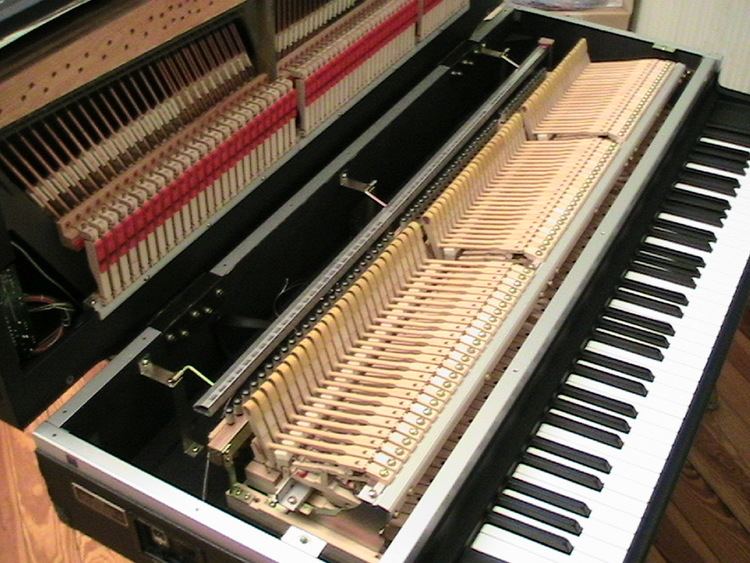 | ||
The electric grand piano is a stringed musical instrument played using a keyboard, in which the vibration of strings struck by hammers is converted by pickups into electrical signals, analogous to the electric guitar's electrification of the traditional guitar.
Contents
Since electric amplification eliminates the need for a resonant chamber, electric grand pianos are smaller and lighter (around 300 pounds (140 kg)), and consequently more portable, than acoustic pianos. Electric amplification also bypasses the difficulty of having to mic a conventional grand piano, and thus makes an electric grand easier to set up with a sound system.
History
Experimental efforts to electrify the grand piano began in the late 1920s with the Neo-Bechstein. In 1939, the first commercially available model, the RCA Storytone, was introduced. These instruments featured the traditional hammered-string mechanism with pickups instead of a soundboard. In subsequent decades, other instruments now referred to as electric pianos were developed and saw wider use; these differ from electric grand pianos in that they produce sound by hammers striking metal tuning forks or reeds rather than strings. In the 1970s, hammered-string electric pianos returned to commercial production, beginning with Yamaha's CP-70 and CP-80, followed by models by Kawai and Helpinstill.
In the 1980s, with the advent of the digital piano, the electric grand piano declined in popularity, and production ultimately ceased. The electric grand sound survives as part of the official General MIDI specification, with most instrument manufacturers licensing the CP-70 and/or -80 sound from Yamaha.
Notable users
The band Keane uses Yamaha's CP-70 exclusively in its music. The band Tokyo Keys also uses the CP-70 (with guitar effects pedals and amplifiers) as an integral component of its sound. Michael Curtes of Polite Sleeper plays a CP-70B as his primary keyboard in live performances.
Tony Banks of Genesis used a Yamaha CP-70 from 1978 to the late 1980s in the band's music and his solo work, as did his bandmates Phil Collins and Peter Gabriel in their respective solo careers.
Other notable users of the Yamaha CP series pianos include Billy Joel ("My Life", "All for Leyna", "I Don't Want to Be Alone", "Sleeping with the Television On", "Pressure", "Surprises"); Steve Hillier of Dubstar, who wrote all three of the band's albums for EMI on his CP-70B; Split Enz keyboard player Eddie Rayner, who played a CP-80 regularly throughout the group's most successful period in the early-mid 1980s; the Edge of U2; Keith Emerson of Emerson, Lake & Palmer; Keith Godchaux and Brent Mydland of the Grateful Dead; Hall & Oates ("Kiss on My List", "Private Eyes"); Rainbow ("Since You Been Gone"); Roxy Music ("Oh Yeah"); Toto ("Hold the Line"); Kerry Livgren of Kansas ("Lonely Wind"); and Aaron Morgan of Seabird.
